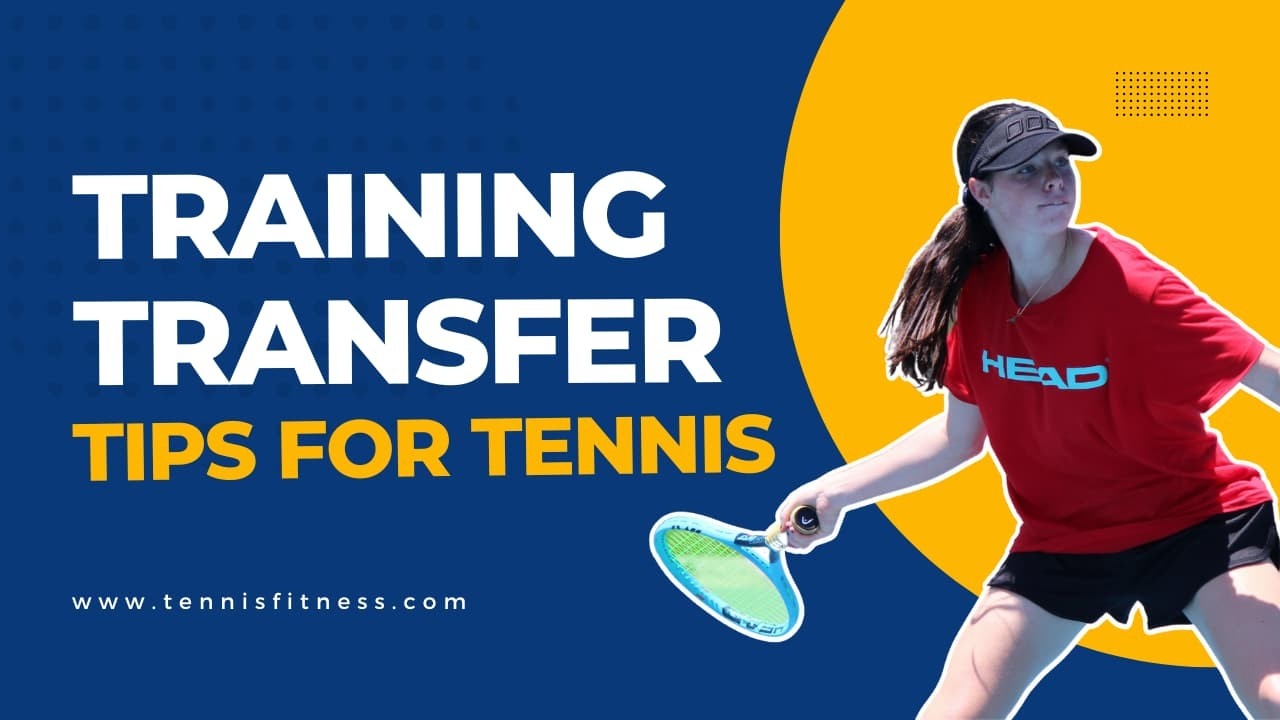Tips For Tennis - Training Transfer
Nov 08, 2022
One of the most common problems I see players having with their Tennis Fitness Training is what I call “training transfer”. Training transfer relates to your ability and success rate of taking what have you learned or physically developed with your off-court training and transferring it onto the court into match play or practice. An example of this would be preseason training.
Imagine you have followed a tennis-specific training plan for 12 weeks and you are feeling fantastic physically, how well you transfer that on-court into your practice sessions and match play is what I call training transfer. Few players really maximize this…
The problem I generally see regarding training transfer is that players come to us for online tennis training whether that be one of our online tennis fitness programs or customized programming and by doing so they get themselves into a high level of strength and conditioning. They become more physically able to perform better on-court, but the results they get training with us don’t always transfer into the results they are getting on the court, does that make sense? Maybe you have experienced that before?
There are some reasons this happens which I will explain in a moment, but before we get to that it is crucial you understand the importance of getting the training transfer right. Here are the main reasons you want to nail this;
- Growth - Growth, improvement, better results look at it however you want. We should all be striving to get better and get as much as we can out of ourselves, this is always going to lead to winning more, playing better, and feeling incredible.
If you are practicing or playing matches at 50% even 70% of what you know you’re capable of your growth is going to be restricted. - Time - Time is precious, as a tennis athlete you need to be ticking lots of boxes on a daily basis. If you want to pursue a career in tennis or maximize your game you need to work hard at it and not just on the court.
You do not want to be wasting precious moments or hours that you could be utilizing to help yourself improve. Just as importantly you want to be using the time you have spent training and maximize that growth with great results during practice and matches. Make sense? Time is valuable! - Confidence - Everyone strives for this, the more of it the better right? However imagine knowing how hard you have worked, how fit and strong you are but not feeling any different on the court, frustrating right? I’ve seen this many times before.
Now imagine you’ve done the work, you’re feeling incredible and you have the ability to walk on the court and back it up, point after point. You can feel the synergy between your off-court fitness training and your on-court play. That’s our aim! And I'm hoping you experience that!
I always encourage players to try and squeeze as much out of themselves as possible. By that I mean look at every practice session, training session, or match as an opportunity to improve and step up to the next level. Without this mindset, you will find yourself floating at 50% of your potential which means you will reach far beneath what you could, who wants that?
Ok, so why do some players have a high training transfer and others feel like nothing changes? Let's take a look at this….
- Motivation - You may be highly motivated to train hard off-court but your motivation to practice or play matches is low. This can be due to a number of factors, some of these include; External pressure from parents (very common), Goals (you have nothing to focus on or strive for), Environment (you are not motivated by the tennis environment you are in e.g coaching, squads, club)
- Intensity - Some players have the ability to step up every session and get things done with the right attitude and intensity no matter how they are feeling or what’s going on in their lives. I believe this is a skill that needs to practice consistently. Too many players go through the motions during practice sessions and even matches, and it becomes habitual. Players with high success find solutions for problems and don’t use challenges as an excuse.
- Too much time on-court - Players can spend too much time on-court per week without enough change and variety in what they are doing in practice sessions or squads. They can plateau in these situations and no matter how hard they are training off-court they won’t want to lift on-court.
- Lack of structure - When a player understands the training structure (on-court / off-court training weekly plan) they are following makes sense to them they are more inclined to buy into the process, especially when they know it is created specifically for them. This is an area many players struggle with, not knowing if what they are doing is really working.
So in order to improve your training transfer what can you do? Good question...
Here are my tips to improve in this area.
Tips For Tennis - Training Transfer
Become Highly Motivated
What is going to make you want to step on-court for every practice session or match feeling like you want to give it your all? Have a think about that and then start to make the changes you need to in order to get yourself in that place. I cannot answer that for you, but I can steer you in the right direction.
It could mean communicating with your parents about what makes you feel best, it could mean chatting with your team (coach/es) about what you respond best to or what you feel needs to change. Definitely set some clear and attainable goals, you need something that you are striving to achieve on-court, you should discuss this with a coach, this is what will get you working harder in the moments when you want to stop!
Boost Your Intensity On-Court
Imagine if you went into each tennis lesson or match in a highly intense mood, how would you feel? Would you be setting yourself up to perform better? 100% yes right… So why not do it? You control this, no matter what is going on in your head or around you, you ultimately control the level of intensity that you deliver. Now if you have done the work off-court and you’re not backing it up on the court with the same intensity, then that’s on you. (Have you seen Rafa Nadal practice?....his intensity is the same for practice and match play)
You have to be willing to step into it each session. We can only expect our bodies to adapt to what we expose them to, so if you physically perform at 50% on the court, then that’s the athlete you’ll become. Remember this becomes a habit, what habit do you want to create? Next time you step on the court be conscious of the level of intensity you are bringing with you.
Tennis Management
Make sure you are training volume (amount of hours you hit each week) aligns well with your physical and mental capabilities. Do too much and you’ll burn out and plateau, do too little and you’ll feel like you are always underdone, especially in matches.
On top of this, you need to consider combining your off-court training (strength and conditioning, preparation, and recovery) with your on-court practice and matches. Getting this right is vital to get the training transfer on point. Check out what we do here to help get this right.
Accountability
It is good to give someone permission to track and manage your training transfer. How would this work? Well, if you have been focused on improving your first step acceleration and you purchased this really cool Speed, Agility, and Power Program (yes it is my program haha) to help and your coach knew you were following it, they could then encourage you on the court to stay focused on this area and motivate you during sessions.
They could also let you know if they felt you were dragging the chain. That’s what accountability should deliver – the reality!
On Court – Off Court Combining
This involves doing on-court tennis drills and combining off-court training drills in the same session. Example: If the focus was improving a player's ability to defend during points but they lacked the ability to be able to sustain the movement for prolonged periods, then we could look at doing some court shuttle runs for 20sec and then move them straight into an 8-ball feed. This could be repeated numerous times with rest intervals.
This training combination offers players the understanding that their need is being targeted and gives them the opportunity to physically work without having to think and then focus under fatigue when hitting the ball. Training combining is a great way to help players transfer their physical capacity into their technical/strategic capacity.
I am hoping this all makes sense to you and that you can take some of my tips for tennis and use them as tools to help improve your training transfer. Nothing will change if you don’t create the change.
So be willing to just start, do something that you know is going to improve your training transfer, do that and I know you will feel the benefits and want to do more!
Let's go!!!
>> Recent Blog: Medicine Ball for Tennis Training




